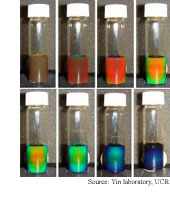|
NEWS
|
Magnetic color
 Electronic ink could one day be made of rust.
The spacing of microscopic iron oxide particles in liquid
can be controlled by magnetic fields, which makes it possible
to change the liquid to any color. The magnetic electronic
ink could be used to make inexpensive displays and electronic
paper. (Highly
Tunable Superparamagnetic Colloidal Photonic Crystals,
Angewandte Chemie International Edition, published
online July 3, 2007)
Electronic ink could one day be made of rust.
The spacing of microscopic iron oxide particles in liquid
can be controlled by magnetic fields, which makes it possible
to change the liquid to any color. The magnetic electronic
ink could be used to make inexpensive displays and electronic
paper. (Highly
Tunable Superparamagnetic Colloidal Photonic Crystals,
Angewandte Chemie International Edition, published
online July 3, 2007)
Light-speed disks
Magnetic bits can be written by ultrafast pulses
of circularly-polarized laser light, which opens a route
to faster data storage devices. The circular polarization
produces a magnetic field that sets a bit; the direction
of the light's rotation determines whether the bit is
a 1 or 0. (All-Optical
Magnetic Recording with Circularly Polarized Light,
Physical Review Letters, June 2007)
Sunny nanotubes
Vertically arranged nanotubes consisting of titanium,
oxygen and varying amounts of iron are photoelectrochemically
active across a wide range of the solar spectrum. The
nanotubes could be used to extract hydrogen from water
using sunlight. (Vertically
Oriented Ti-Fe-O Nanotube Array Films: Toward a Useful
Material Architecture for Solar Spectrum Water Photoelectrolysis,
Nano Letters, published online July 3, 2007)
Nano flashlight
A color-tunable visible light source made from
individual potassium niobate nanowires makes it possible
to image objects that are too small to be seen with optical
microscopes. The nanowire light could be used to probe
the insides of living cells, as well as enable tiny optical
communications devices. (Tunable
Nanowire Nonlinear Optical Probe, Nature, June
28, 2007)
Single cell sensor
Researchers have found that placing a living cell
just above a transistor provides a way to measure the
amount of ions flowing into the cell. The technique could
be used to test drugs, detect toxins and diagnose diseases.
(Recombinant
Serotonin Receptor on a Transistor as a Prototype for
Cell-Based Biosensors, Angewandte Chemie International
Edition, published online June 19, 2007)
Jumbled circuits
Computer chips of the future could be made from
inexpensive jumbles of nanotubes or nanowires. A study
of irregular networks shows that such chips are physically
plausible and provide a better balance of performance
and cost-effectiveness than similar networks-on-chips
with highly-organized components. (Nature-Inspired
Interconnects for Self-Assembled Large-Scale Network-On-Chip
Designs, Chaos: An Interdisciplinary Journal of
Nonlinear Science, June 2007) |
FEATURES
|
View
from the High Ground: ICL's John Pendry
Physics as machine tool, negative refractive
index, metamaterials, shattered wine glasses, higher capacity
DVDs, scientific backwaters, risk perception and practice,
practice, practice.
|
How
It Works: Quantum computing: qubits
Photons, electrons and atoms, oh my! These particles are
the raw materials for qubits, the basic building blocks
of quantum computers. |
|
 |
News RSS feed 
Blog RSS feed 
Bookshelf RSS feed

New: TRN's
Internet Services
TRN's Jobs Center
|
| |
|
| |
|
| |
"Physics
is to the rest of science what machine tools are
to engineering. A corollary is that science places
power in our hands which can be used for good or
ill. Technology has been abused in this way throughout
the ages from gunpowder to atomic bombs."
- John Pendry, Imperial College London |
|
| |
|
| |
Thanks
to Kevin from
GoldBamboo.com
for technical support |
|

